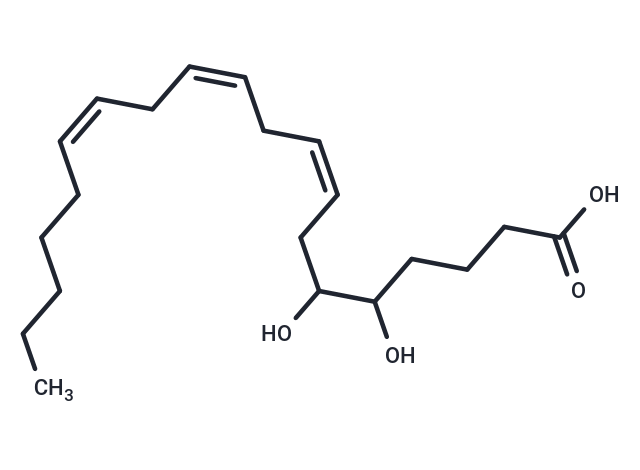- Remove All
 Your shopping cart is currently empty
Your shopping cart is currently empty
(±)5(6)-DiHET
5(6)-DiHET is a racemic compound synthesized through the action of epoxide hydrolases on 5(6)-EET, encompassing both enantiomeric forms. It serves as a quantitative marker for 5(6)-EET, facilitating its measurement by utilizing the compound's conversion to 5(6)-δ-lactone in solution. Additionally, 5(6)-DiHET activates large-conductance calcium-activated potassium (KCa1.1/BK) channels in rat small coronary artery smooth muscle cells, supporting its biological significance in vascular regulation. It also acts as a substrate for sheep seminal vesicle COX, leading to the in vitro production of 5,6-dihydroxy prostaglandin E1 and F1α metabolites. Notably, its levels diminish in the plasma of rats subjected to a high-fat diet, indicating a potential role in the pathophysiology of hyperlipidemia.

(±)5(6)-DiHET
| Pack Size | Price | Availability | Quantity |
|---|---|---|---|
| 10 mg | Inquiry | 8-10 weeks | |
| 50 mg | Inquiry | 8-10 weeks |
Product Introduction
| Description | 5(6)-DiHET is a racemic compound synthesized through the action of epoxide hydrolases on 5(6)-EET, encompassing both enantiomeric forms. It serves as a quantitative marker for 5(6)-EET, facilitating its measurement by utilizing the compound's conversion to 5(6)-δ-lactone in solution. Additionally, 5(6)-DiHET activates large-conductance calcium-activated potassium (KCa1.1/BK) channels in rat small coronary artery smooth muscle cells, supporting its biological significance in vascular regulation. It also acts as a substrate for sheep seminal vesicle COX, leading to the in vitro production of 5,6-dihydroxy prostaglandin E1 and F1α metabolites. Notably, its levels diminish in the plasma of rats subjected to a high-fat diet, indicating a potential role in the pathophysiology of hyperlipidemia. |
| Alias | (±)5,6-DiHETrE |
| Molecular Weight | 338.5 |
| Formula | C20H34O4 |
| Cas No. | 213382-49-1 |
| Storage | Powder: -20°C for 3 years | In solvent: -80°C for 1 year | Shipping with blue ice. |
Calculator
In Vivo Formulation Calculator (Clear solution)
Dose Conversion
Tech Support

Copyright © 2015-2025 TargetMol Chemicals Inc. All Rights Reserved.




